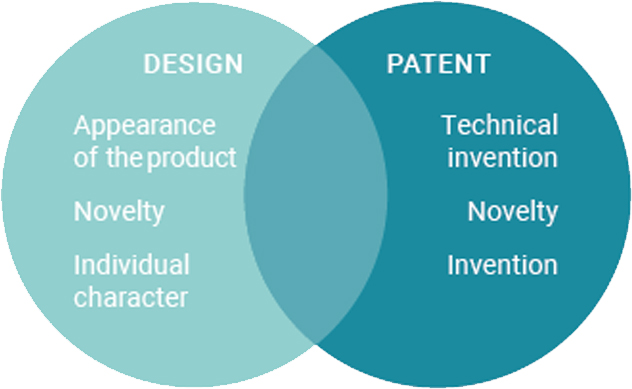European design protection – worth your money?
This is an Insight article, written by a selected partner as part of IAM's co-published content. Read more on Insight
Every company that spends money and resources on research, development and marketing for its products needs assurance that competitors (or other third parties) cannot take advantage of its innovation. Profiting from innovation requires a good business model and an IP strategy is an important part of that business model.
Unlike trademarks, patents and copyright – which are well known and commonly used – design protection is sometimes forgotten or underestimated. However, the design of products, packaging, logos, drawings and artwork plays a key role in distinguishing new products from those of competitors.
This chapter outlines the benefits of Community design protection valid in EU member states, including its historical background, legal conditions and scope.
History
The Community Design Regulation (6/2002) provides EU-wide protection for both unregistered and registered Community designs. Unregistered design rights have existed since 6 March 2002, while the registered form of the right became available on 1 April 2003.
The EUIPO was appointed as the authority to manage design registrations in the European Union. In 2006 the European Union became a member of the Hague Agreement, meaning that it may be designated in an international design registration via the WIPO.
From the last EUIPO Design Focus Report: 2010 to 2019 Evolution (https://euipo.europa.eu/ohimportal/en/news/-/action/view/5623109), it is clear that the registered Community design is a progressive success and a force to be reckoned with in the global marketplace for innovative business. From 2003 until 2020 nearly 1.6 million applications for registered Community designs were filed, with an average annual growth of 3.5%. More than 813,000 registered Community designs were in force on 1 January 2020. The forecasted filing volumes for 2020 provide an accumulated volume of approximately 1.1 million registered Community design filings since the beginning of 2010.
The global top 10 applicants from 2010 to 2019 – which as a group represents 5.9% of overall filings – are all global leaders in design-intensive industries and commercial sectors.
Class 6 (furnishing) tops the ranking of most filed classes, followed by Class 2 (articles of clothing and haberdashery) and Class 14 (recording, telecoms or data processing equipment), which had the highest average annual growth rate (9.1%) among the top 10.
The top filing countries are headed by Germany and Italy, followed bythe United States in third place. Japan and the Netherlands close the ranking with positive strong growth. Collectively, the top 10 accounted for 77% of all filings that were directly submitted to the EUIPO during the past decade.
An application for single or multiple registered Community designs can be filed directly via the EUIPO. It is also possible to file a registered Community design via the Hague System offered by the WIPO. In 2019 about 13% of applications were filed via the WIPO and 87% directly at the EUIPO.
Before the implementation of the Community Design Regulation, only Benelux had introduced a uniform design protection law. In all other EU member states, the protection of designs was regulated by the relevant national laws and was confined to the territory of the member state concerned. This inevitably caused problems – it led to conflicts in the course of trade between member states, created possible divisions in the internal market and posed an obstacle to the free movement of goods. The creation of the Community design was therefore necessary. A registered Community design is a unitary right that has equal effect across all EU member states.
With Brexit in force since 1 January 2021, the United Kingdom is no longer protected under a newly registered Community design filing. Existing registrations have, automatically and free of charge, been converted into a UK clone registration. However, as a transitional rule, EU filings completed before 1 January 2021 and registered after the Brexit date can be converted into a UK registration, retaining the original filing date by filing a special request at the UK Intellectual Property Office within the sunrise period (until 1 October 2021) and by paying the official fees. The novelty requirement is imperative for design owners and they are well advised to act in time.
Definition of ‘design’
Mere ideas and concepts do not qualify as intellectual property; instead, intellectual property defines and protects human innovations and creations. A design protects the appearance of a product and is intrinsically linked to that product. In a legal sense, an industrial design constitutes the ornamental or aesthetic aspect of a product. An industrial design may consist of three-dimensional features (eg, the shape of an article or its packaging) or two-dimensional features (eg, patterns, lines or colour).
To qualify for Community registration, a design must be novel and possess individual character:
- ‘Novel’ means that no identical design has been disclosed before it. If two designs differ only in immaterial details, they will still be considered identical.
- Possessing ‘individual character’ means that the overall impression conveyed to the informed user differs from that conveyed by any other previous designs.
With respect to the requirement that a design must be novel, the Community Design Regulation provides for a one-year grace period in which a business can investigate whether a product is worth protecting before applying for registration. Almost any industrial or handicraft item can be eligible for design protection (except computer programs). Words, sounds and colours are examples of elements that do not qualify as designs, as they cannot constitute the appearance of a product. However, they may qualify for trademark protection.
Design protection is limited to the appearance – as opposed to the functionality – of the product whose design is registered. Products whose appearance is solely dictated by their technical function cannot qualify for design protection; however, they may qualify for patent protection. Registered Community designs filed at the EUIPO include blueprints, packaging, computer icons, graphical symbols, cartoon characters, colour logos, posters, furniture, parts of products, logos, typefaces, drawings and artwork, as well as get-ups and ornamentation.
Scope
A Community design should serve the needs of all industry sectors in the European Union. Some of these sectors produce large numbers of designs for products that have a short market life, where protection without the burden of registration formalities is an advantage and the duration of protection is less significant. However, there are also industry sectors that value the advantages of registration for the greater legal certainty that it provides and require the possibility of a longer term of protection, corresponding to the foreseeable market life of their products.
This consideration led to the creation of two forms of protection:
- the short-term unregistered Community design; and
- the longer-term registered Community design.
Both provide protection against the manufacture, sale and import and export of any product incorporating the protected design without the consent of the rights holder. However, registered and unregistered Community designs are quite different in terms of their granted rights and duration.
An unregistered Community design provides protection for three years from the date on which the design is first made available to the public. A registered Community design provides protection for five years from the date of application and can be renewed every five years up to a maximum of 25 years.
The scope of protection of the two rights is the same, only the rights granted differ. The exclusive right of an unregistered Community design holder is limited to designs that are a conscious, intentional copy of the protected design, made in bad faith. The right of the holder of a registered Community design is broader, as it can also prevent others from commercially exploiting identical and similar intentional and unintentional copies of the registered design. Proof of the date of creation is not required, since the date of filing the registration takes precedence (see Table 1).
Table 1. Registered and unregistered EU designs
| Unregistered EU design | Registered EU design | |
|---|---|---|
| Registration needed? | No | Yes |
| Costs | No | Yes |
| Duration | Three years from making public | Yes |
| Scope | EU member states | EU member states |
| Requirement | Novelty, individual character | Novelty, individual character |
| Right | Prevents only against bad faith identical copy | Prevents against identical, similar, intentional and unintentional copy |
| Proof | Archive first publication | Registration certificate – date of application |
Determining which option to choose depends on many factors, including budget, type of product and timing. If an unregistered Community design is chosen, it is crucial to document the first date on which the design is made available to the public.
Filing conditions
The procedure to apply for a registered Community design at the EUIPO is straightforward. It does not include an examination of whether the design is novel or possesses individual character. The examiner checks only whether the submission qualifies as a design, if the filed representations are clear and consistent views of the product and whether it contains any element that goes against public policy or morality.
The procedure does not provide for opposition; however, third parties may request that a design registration be declared invalid via an administrative procedure before the EUIPO. This invalidity procedure can be launched against a design only once it has been registered.
An applicant can file multiple designs in one application, without limitation. The only condition is that the products to which the design is applied belong to the same Locarno class (ie, the same type of goods); however, this condition does not apply when the application concerns ornamentation. Multiple applications are frequently used (eg, for variations in the style and colour of products, for furniture sets and for variations in logos), as the extra cost per additional filing is relatively low.
Besides the relatively low cost of the official fees (€350 for a single design) and the simple procedure, registration is also very fast. For most applications a registration certificate is obtained within a few days. Compared to the timeline and procedure for trademarks and patents, the design registration process is fast, straightforward and inexpensive. The Community design registration can be an effective priority filing for consequent filings in other countries.
Registered Community design as complement or alternative
A registered Community design is one choice from a palette of IP rights – and one IP right does not necessarily exclude another. Registered and unregistered Community design rights can be used cleverly to optimise all IP rights or as an alternative between them.
Trademarks
Where a company has designed a word mark with a complex figurative logo and produces a diverse range of products, registering trademarks in all Nice classes will be costly. In this scenario, registering a new logo as a Community design could be an option – this would extend protection to all kinds of products that include the logo. Further, the rights holder can prevent its logo from being used by third parties on goods other than those with trademark protection. As an added incentive, no use obligation exists for designs (in contrast to trademarks).
A design registration would complement the trademark registration, with the aim of strengthening protection against merchandise infringement (see Table 2).
Table 2. Design registration has certain advantages against trademark registration
| Advantages | Disadvantages |
|---|---|
| Covers all goods and services | Duration of protection limited to 25 years |
| Independent of the product | Design must be novel and have individual character to be valid |
| Less costly than trademark registration | To prove infringement, the degree of resemblance must be stronger than for trademarks |
Descriptive word marks: The EUIPO has been refusing registration of descriptive word marks accompanied by a simple figurative logo. These types of logo are and will increasingly be filed as registered Community designs instead. However, whether this option will give the intended protection remains to be seen.
Distinctiveness: Many new product and packaging shapes that do not satisfy the distinctiveness requirement for trademark protection may qualify as a Community design. Design law may therefore serve as an important supplement to trademark law, as in the perception of consumers it is used as a trademark.
Patents
Many products include a common area that covers both patent and design rights (see Figure 1) and are frequently protected by both types of right. Although a design may not comprise the appearance of a product, which is solely dictated by its technical function, the EU Designs Regulation does not limit the protection of designs (and parts of designs) that fulfil a technical function. Design protection can therefore be a relatively low-cost addition to a patent application.
Figure 1. Many products include a common area that covers both patent and design rights

When applying for both applications, great care must be taken regarding the timing of filing and publication, in order not to harm the novelty of either claim. In these circumstances, deferment of publication can be a solution.
Copyright
Copyright protection depends on national laws and arises without any formal requirements through the creation of a work of literature, art or science. It requires proof of the date of creation and proof of authorship. Many works that are protectable under national copyright laws are also protectable as a registered Community design.
The main advantage of a registered Community design over copyright protection is that it covers all EU member states, providing one clear right that is governed by a single law. Further, the proof of date and authorship is covered by the registered Community design. However, the term of protection is shorter than that for copyright, which runs during the life of the author and for 70 years thereafter (under Dutch Copyright law).
To protect or not to protect?
When should you choose to protect an innovation as a registered Community design?
Special designs need protection, as this will enhance their value: a registered design creates a marketable asset and protects against unintentional copying and counterfeiting. So, have you developed or created a new design for a product, packaging, logo or ornament? Have you or your IP adviser performed a search of the Internet and available databases to check the novelty of the design, and was the outcome positive? If so, you should apply for a registered Community design, including the correct illustrations of all perspectives necessary to show every feature of the design.
Registration offers the benefit of being the presumed exclusive owner of the design in 27 countries – and all future EU member states – for up to 25 years. On registration, you may indicate on the product and in advertisements the symbol and state that your product is a registered Community design.
A registered Community design gives you a defensive advantage. Competitors are clearly informed about the alleged exclusive right and the online public register will show the design right if a search is performed. The registered Community design can be used in the case of infringement – initially in a letter of summons and later (if necessary) in court. Further, counterfeiting and fraud are easier to address with a certificate in hand – for example, the registered Community design can be registered at Customs.
Besides the defensive advantage that it provides, a registered Community design right counts as a company asset that may be traded, licensed or pledged and has value in case of sale. A registered Community design does not limit the other IP rights that can be applied to innovations: it is a valuable complement to trademarks, patents and copyright.
Community design registration is worth your money and your company is worth Community design registration!





